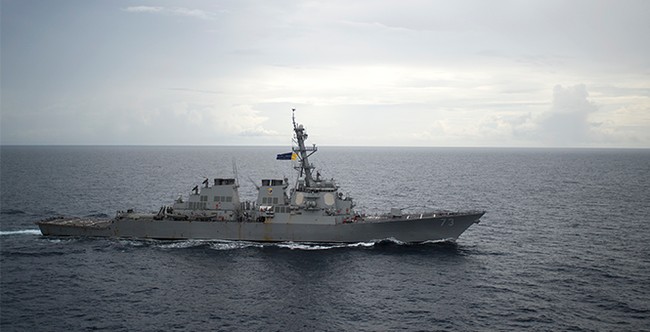Major wars rarely end quickly. The Napoleonic Wars lasted 12 years, from 1803 to 1815, and embroiled much of the world in conflict. Our own War of 1812 was one facet of that larger conflict. The Great War (World War One) lasted over four years, from 1914 to 1918. The Second World War, the last such great conflict, lasted from 1939 to 1945, six years and one day.
Major wars, then, generally drag on for years, and each time, the destruction seems to become more and more horrific. A recent piece from The Atlantic Council's publication, New Atlanticist, penned by Lieutenant Colonel Brian Kerg, who is a Nonresident Fellow with the Indo-Pacific Security Initiative and the Scowcroft Center for Strategy and Security, assures us that any war between China and the United States is likely to be of similar scope, with possibly even greater destruction. He makes some good points—but, in my estimation, misses one huge one.
First: LTC Kerg correctly points out a flaw in what planning has taken place between the U.S. and its allies (at least what planning we know about) for such a war, and how said plans seem to be focused tightly around an attempted reconquest of Taiwan by China, with the possible addition of a second war on the Korean peninsula.
In the United States, war-game results might, for example, inform prioritization of weapons procurement by the Office of the Secretary of Defense or the enthusiasm for Congress to invest in security infrastructure across the Indo-Pacific. Recently, an unclassified Center for Strategic and International Studies war game played out a scenario in which the United States fought China and won—albeit at great cost. While informative, this game focused largely on a short, decisive fight in and around Taiwan and the first island chain.
The same trend is borne out in the literary genre of “useful fiction.” Recent novels such as Ghost Fleet and White Sun War depict wars fought primarily between the United States and China. Almost always in such works, the war is brought to a satisfying conclusion over a relatively short time frame.
Kerg is likely correct on this; most scenarios, whether described by talking heads on news programs covering geopolitics as well as speculative fiction, seem to draw a line around Taiwan and Korea and count on this being the extent of the conflict; but any such conflict is almost certain to 1) not end quickly, 2) drag in other nations beyond the original combatants, and 3) to force the forming of alliances. And the pieces are already in place for much of this. Tsar Vladimir I is still in place in Moscow, China is still seeking every advantage it can find, not excluding infiltrating our own government.
See Related: BREAKING: Vladimir Putin Wins a Fifth Term As Russia's President
Hu Knows: Swalwell Bundler Fang Fang Breaks Cover, Reveals FBI Offered Her $1 Million
Second: Kerg describes his prospective U.S./China conflict as a swift explosion in the West Pacific, with horrible losses on both sides; that's certainly a realistic assessment:
The opening pages showcase the trends of modern war games and novels, where naval combatants, fifth-generation aircraft, missile forces, and non-kinetic effects wreak havoc in the war’s opening days, crippling the air and naval power of the belligerents. Thousands upon thousands are killed in this first stage of the conflict. But the war expands horizontally, with China, Russia, and North Korea aligned against the United States, Taiwan, Japan, the Philippines, Australia, South Korea, and others. Fighting occurs in multiple theaters within United States Indo-Pacific Command and beyond, including a massive conflagration on the Korean peninsula. Soon, the ability to hurl precision munitions back and forth culminates as expenditure rapidly outpaces production capacity and as US fuel stocks in the Pacific dwindle. With pressure increasing and options decreasing, tactical nuclear weapons are employed on the battlefield . . . and yet the war drives on.
Thus would end the first chapter. The reader turns the page, which says: “Three years later.”
Note that, like in both world wars, things start pretty localized, but matters quickly get out of hand. That "three years later" is key:
And with some skillfully placed exposition, the author reveals the massive changes that have occurred across society as belligerents commit to a long, bloody war. Nations have fully mobilized their economies to support what is now an existential war. Drafts and conscription are made mandatory to fill and maintain the ranks of multiple field armies, amphibious corps, fleets, and air forces. The war is not limited to the first island chain, but has multiple theaters that span the globe and escalates horizontally, with simultaneous conflicts drawing in additional belligerents. Emergency powers are universally invoked by executive branches, curtailing liberties in even the historically freest societies. The threat of nuclear holocaust is ever-present, and continuous fighting through tactical nuclear exchanges shatters previous conceptions of escalation management.
In other words, a prolonged conflict would be ruinous, not only economically, not only demographically, but culturally, with a loss of liberty and prosperity unlike that in any former war, with the possibility of nuclear Armageddon added in, just to make things more interesting.

But something is missing from Kerg's analysis: Biology and asymmetric warfare, and they center around the fact that China and Russia, the primary antagonists in such a fracas, both have significant economic and demographic problems that preclude them from being able to sustain any prolonged conflict. This would likely motivate them to seek other solutions. There are two courses they can pursue here, and there are signs that this may already be happening.
First is biology. There is a saying going around that while World War I was the war of chemists, and World War II was the war of physicists, World War III will be the war of biologists, and if that doesn't scare the kapok out of you, then you haven't been paying attention for the last few years. Consider the COVID-19 panic, only with a lethal pathogen, say, a gene-modified Ebola virus; that has the potential to wipe out a significant portion of the population at little cost to the aggressor. What's more, what people aren't killed by the pathogen may well perish in the ensuing collapse of institutions and infrastructure.
Consider also that illegal Chinese bio-labs exist now, today, on American soil.
See Related: What Most Media Outlets Missed From the Congressional Report About the Illegal CA Biolab
Second, the possibility of asymmetric warfare, very likely carried out by infiltrators into the United States. My Townhall colleague Kurt Schlichter's latest book, "The Attack," presents just such a horrible scenario, and it's all too plausible. Millions of young, unaccompanied, military-aged men have flooded into our country, and as I keep repeating, we have very little idea who most of them are, where they are going, or what they intend to do when they get there. But a few hundred, or a few thousand, with some rudimentary training and minimal planning, could do untold damage to our infrastructure, as well as to our citizens.
See Related: Former FBI Top Brass Warn Congressional Leaders of 'Imminent' Terror Threat Due to Border Crisis
There is an old saying in military circles, that we are always training to fight the last war. I've seen that first hand; most of my early years in Uncle Sam's colors were focused on training to fight the Soviet Union in Western Europe, not the army of an Arab nation in Mesopotamia; yet in January of 1991, there we were, getting ready to jump across the border into Iraq.
That is the fear here. The rise of biotechnology and the willingness of non-state actors to carry out atrocity upon atrocity have changed things since the world wars. Our current threats may not come from without; they may already be here, within our borders, and if our planning doesn't take that into account, the next war may well be America's last war.














